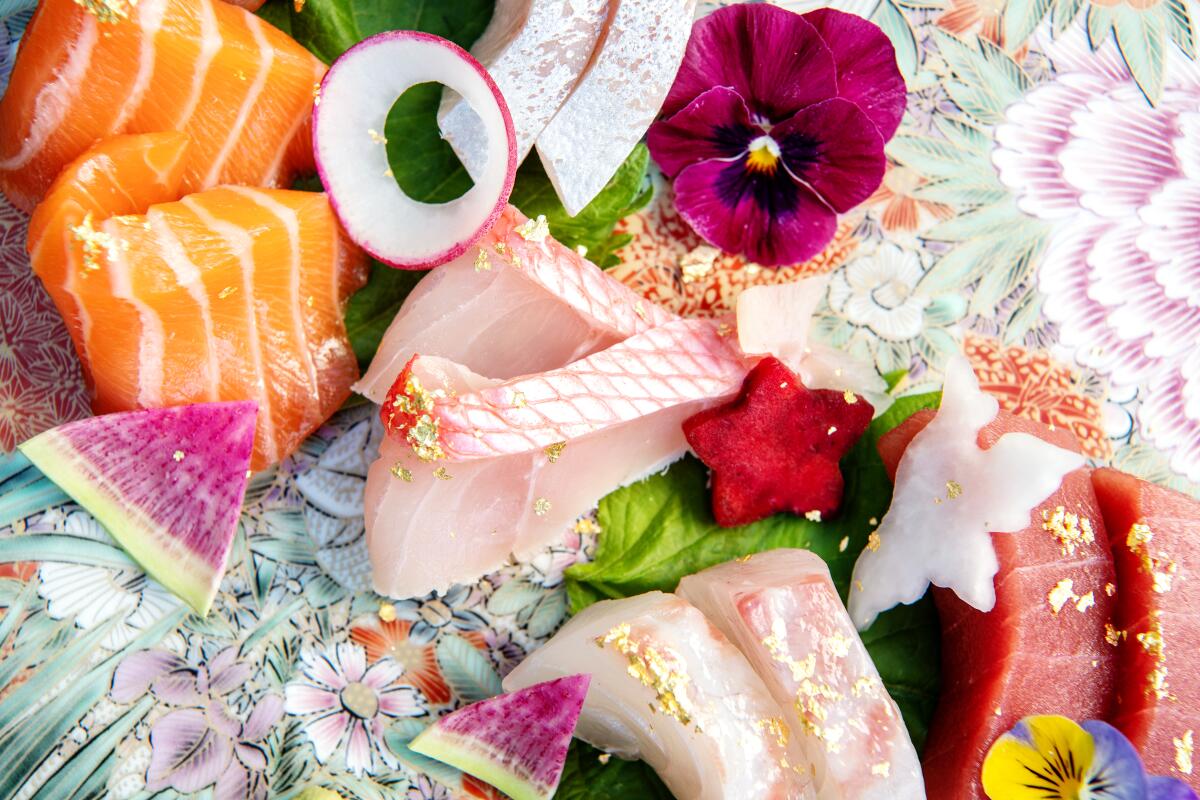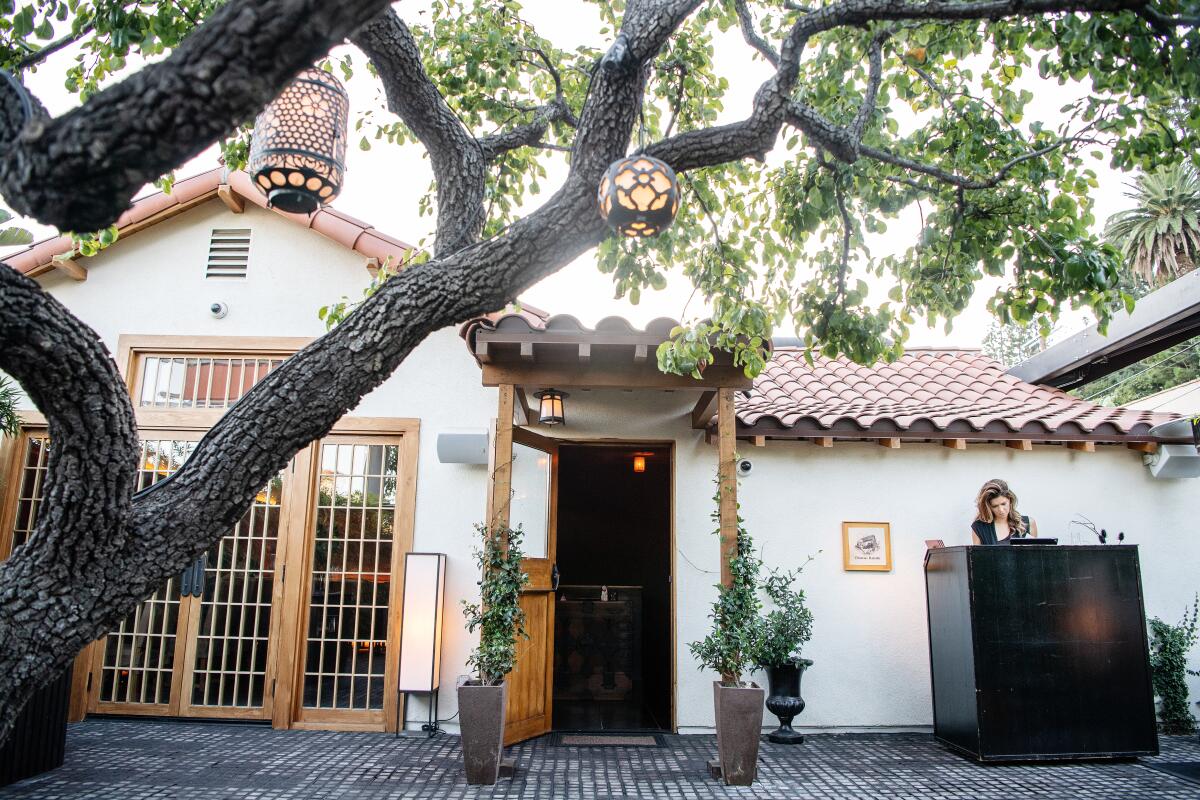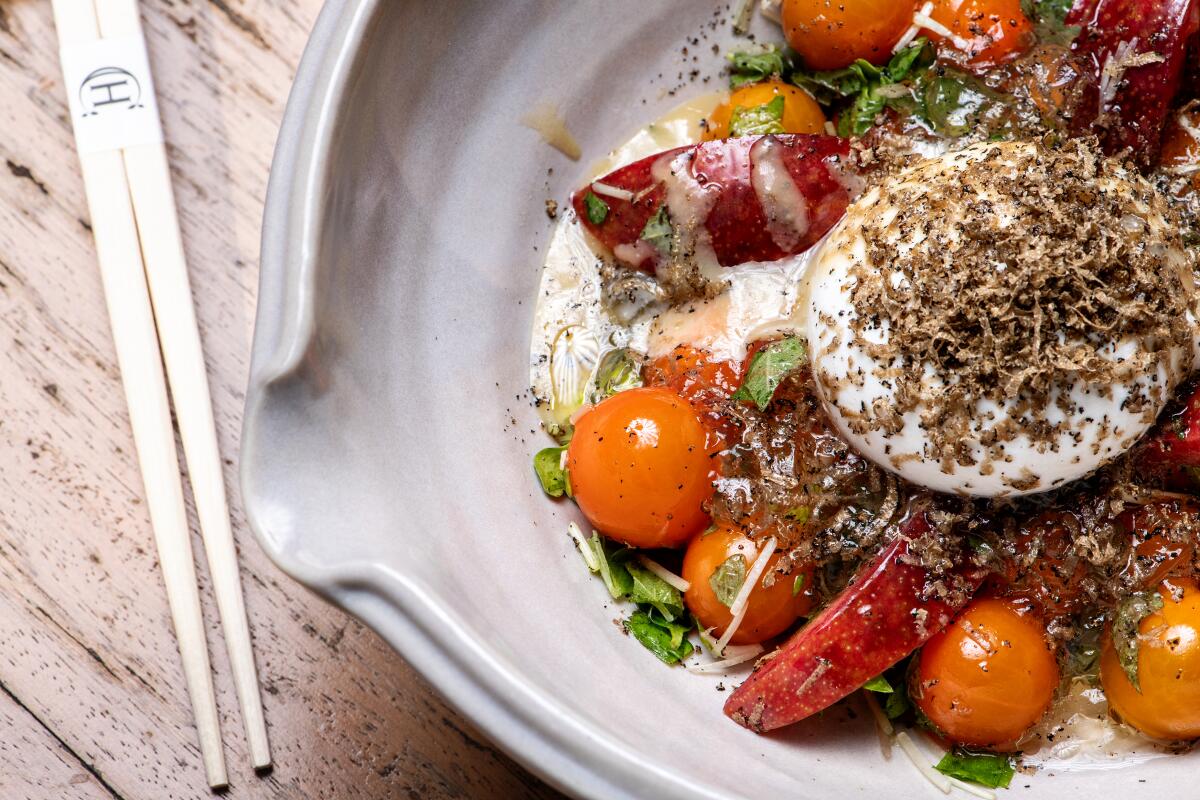Review: The Chateau Marmont’s Japanese restaurant disappoints in more ways than one

- Share via
The sashimi arrived on a plate that resembled an Ed Hardy tattoo. Girthy scraps of fish, some nearly an inch thick, lay inelegantly among a couple of shiso leaves and radish slivers. Pieces of snapper, amberjack, salmon and tuna, some with jagged bits of skin attached, were scattered with flecks of gold leaf. I bit into a piece of snapper, or tried. My teeth couldn’t quite make it through. A food runner arrived with another dish. “And if that wasn’t luxury enough,” he said, presenting a quenelle of ice cream with a slab of uni laid across, “more gold!” I took a deep breath; the gilt was almost too much to bear.
My original plan for this review was to use a “Rashomon”-like device to tell the tale of Chateau Hanare, the Japanese restaurant from Reika Alexander, owner of New York’s En Japanese Brasserie, in collaboration with the Chateau Marmont, the storied 1929 Sunset Strip hotel that boasts what’s likely the highest celeb-sightings-per-square-foot ratio anywhere in Los Angeles outside of the “hiking” loop at Runyon Canyon. “Rashomon” told the story of the murder of a samurai; this would have been about the murder of cuisine. I’ve got a few hundred words I could write about that sashimi plate, which tasted like licking the inside of a fish tank.
Some of that space, though, will need to be spent on a different topic. More than halfway through my third, and last, meal at Chateau Hanare, my dining companions and I began looking at articles about the restaurant’s chef. While I will frequently read up on buzzy or up-and-coming chefs in advance of going to a restaurant, in this case, the chef was not the draw. So I put it off. An oversight, possibly, but it allowed me to solidly form my opinion of the restaurant before I learned anything about the chef, Abe Hiroki.

Two years ago, a female manager at En Japanese Brasserie in New York, where Abe was (and still is) executive chef, filed a lawsuit claiming years of sexual harassment. Abe, she alleged, simulated sex acts, groped and insulted her, and made inappropriate comments. He did much of this in Japanese, she claimed, which many of the restaurant’s employees did not speak or understand. (When asked to comment, a representative of the company said it “does not believe that any of the allegations occurred” and declined to comment further, noting the case was settled out of court.)
For a critic, this revelation raises some questions. I understand the reasons for not reviewing places helmed by those who have credible allegations against them. I considered not reviewing Chateau Hanare, despite finding out about the chef’s alleged history late in the process. (And then, while writing this piece, I learned that the Chateau Marmont’s owner, André Balazs, has his own issues with alleged misconduct.) I’m close with a number of female chefs and so I asked two of them, who work at different restaurants, on different sides of the globe, if they thought I should go ahead with the review. Their responses were identical: You should.
Here’s why: Although Mario Batali and John Besh no longer (officially) have restaurants following allegations of misconduct, celebrity chefs represent a tiny sliver of an industry where abuse is commonplace. The vast majority of bad actors are people who aren’t household names. They’re chefs and cooks who have been in the industry for years, moving from kitchen to kitchen and restaurant to restaurant. They’re not media darlings. They don’t have TV shows or their own prepared food lines in grocery stores. As such, bad behavior can sometimes fly under the radar, even when it’s formally named in a lawsuit.
In the case of Abe, this didn’t even fly under the radar: The lawsuit brought against him was picked up by Variety, the New York Post and other outlets. But it was buried, ultimately, perhaps due to higher-profile scandals. No media coverage of Chateau Hanare that I’ve seen has mentioned the allegations, even in passing.
So instead of trying to tackle can-you-separate-art-from-artist issues that are beyond the purview of this column, my questions are more rudimentary: Why does this guy still get to have a restaurant? And why, after allegedly harassing a manager for years, was Abe given another restaurant on the other side of the country, operated by the same company?
A separate issue, but one that makes writing this review a whole lot simpler: The food at Chateau Hanare is bad. Can’t it find a better chef?

Chateau Hanare, located on the eastern fringe of the Chateau Marmont property (but not on the grounds of the hotel itself), with a low-slung Japanese-style tile roof, is certainly a pretty restaurant. The outdoor area, where diners can eat ensconced in a mini-bamboo forest at slightly-too-low tables illuminated by tasteful lantern light, is especially charming. Diners will titter at the naughty shunga erotic art wallpapering the bathrooms.
Servers are attentive, if green, and try their hardest under what seem like difficult conditions. A manager was shadowing my server during a meal (“Quality control,” the server said through slightly clenched teeth) and at one point she awkwardly wrested a water glass out of my dining companion’s hand when she realized sparkling water had been poured instead of still water. As in, physically peeled it out of her hand.
The menu at Chateau Hanare reads like a preteen’s vision board — scattershot, loosely based around a theme (Japanese food) and with a few head-scratching outliers. A $150 six-course “kaiseki” meal that features the requisite Wagyu beef lives next to uni toast, but also avocado toast and something called a “choux trio.” There’s sashimi and the familiar miso black cod, but also shrimp ajillo and a kale salad. Squash blossom dishes bizarrely note the sex of the squash blossom (one uses a male blossom, the other a female) but don’t say why.
The male squash dish, a blossom stuffed with shrimp, is one of the more unfortunate things I’ve eaten recently. The sad flower comes jammed with a compacted nugget that has the texture of rubbery gefilte fish. It’s given the coup de grâce of a sprinkling of sweet strawberry powder, which moves the unholy crustacean chonker from a place that is merely lamentable to one that is truly foul.

A tomato and truffled burrata salad is equally confounding. Whole, uncut tomatoes sit in dashi gelée with plum slices, surrounding a mound of burrata that has the texture of a clay face mask. It’s all covered in some diesel-y shredded black truffles. An order of crispy fried chicken is anything but crispy, and has a distinct bready, black pepper-heavy flavor that recalls the hot food section at an Albertson’s.
The attitude toward much of the food seems to be, if you blanket everything with something that looks expensive, it will distract diners from noticing the taste. Truffles and gold leaf, therefore, abound. But the truffles don’t seem fresh, and are put on dishes where they don’t belong. The haphazard deployment of gold leaf is the kitchen’s way to try to put lipstick on a pig. It’s still a pig.
Lipstick-covered pig might have been better, in retrospect, than a chocolate tart that came out not cooked all the way through, or an ikura bowl that tasted like a mouthful of fishy gummy bears. Not everything was bad. The chicken nanban — a hot-and-sour Kyushu specialty — had a satisfying Panda Express-like tangy sweetness. A good piece of Wagyu beef, served with the kaiseki menu, was properly cared for. Amberjack collar was slightly overcooked but acceptable.
Ultimately, the restaurant world is a zero-sum game. There are limited spaces, and a limited number of spots that a city and its people can support. You want some good Japanese food? Take a drive to Sawtelle, or Little Tokyo, or Gardena. With so many good restaurants in Los Angeles and so many deserving chefs who haven’t been named in workplace-misconduct lawsuits, it’s exhausting to think that anyone would go here for a meal.
Chateau Hanare
Location: 8097 Selma Ave., Los Angeles, (323) 963-5269, hanarela.com
Prices: Appetizers and smaller dishes $5-$36, sushi and sashimi $14-$50, entrees $16-$145; desserts $4-$16.
Details: Credit cards accepted. Full bar. Valet parking.
Recommended dishes: Wagyu beef, chicken nanban, still and sparkling water.
More to Read
Eat your way across L.A.
Get our weekly Tasting Notes newsletter for reviews, news and more.
You may occasionally receive promotional content from the Los Angeles Times.










